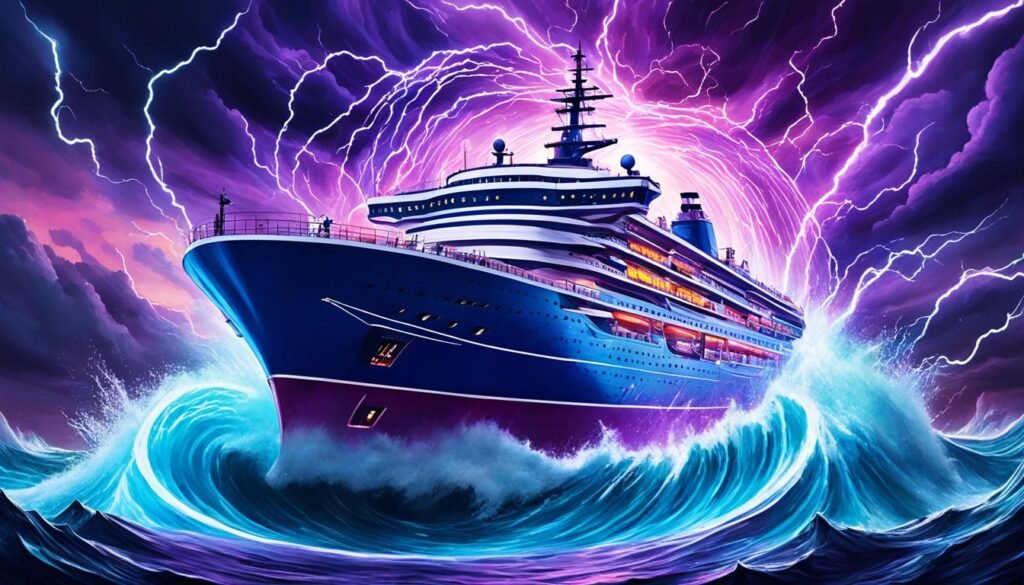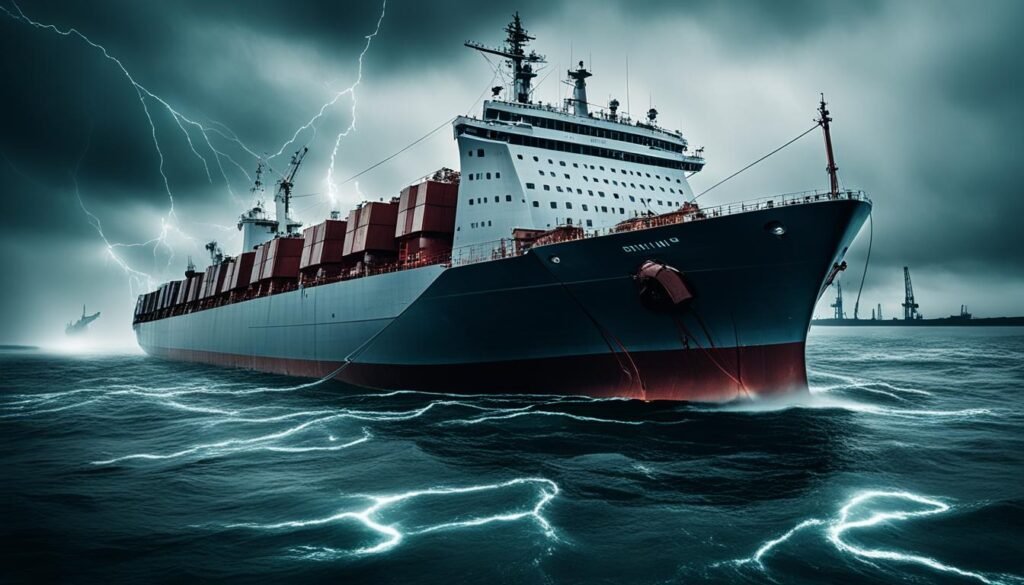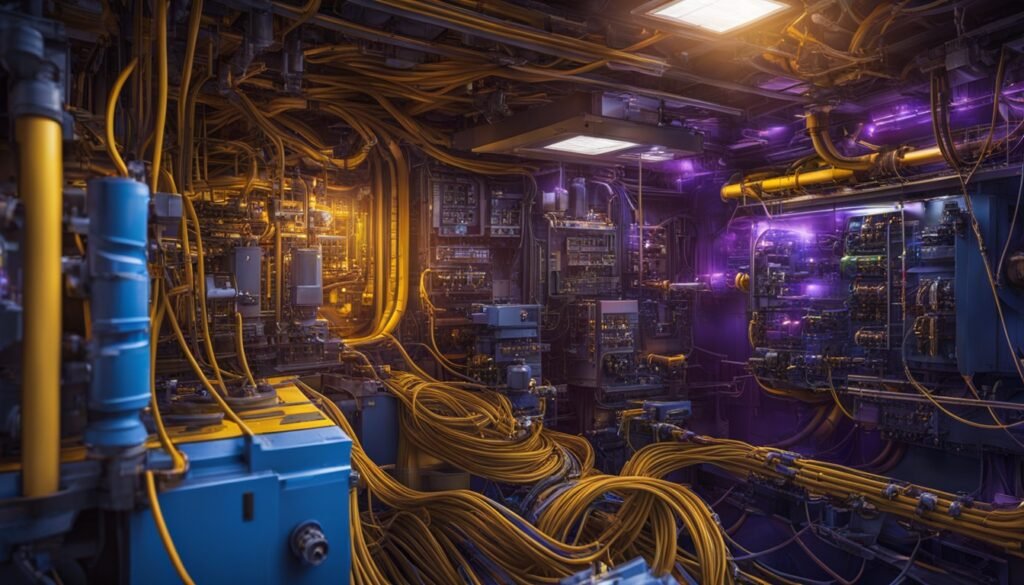I’ve always been drawn to the mysteries of the sea and the secrets of ships. The electric currents around ships have always intrigued me. They are a hidden force that affects ship safety and strength.
This article will explore why electric currents surround ships. We’ll look at how the ship’s electrical systems, seawater’s conductivity, and potential dangers work together. By understanding this, we can make maritime operations safer and more reliable.

Let’s dive into the world of electric currents around ships. We’ll explore maritime electromagnetics, naval electrical systems, and the importance of shipboard power distribution. Join me as we uncover the hidden forces that shape the sea and keep ships safe.
Understanding Electric Shock Drowning (ESD)
Electric Shock Drowning (ESD) is a serious danger that happens when alternating current (AC) moves through fresh water and touches a person. This can cause the muscles to freeze, making it hard to breathe and leading to drowning. ESD is more common in places like lakes and rivers because freshwater makes the current go through the body more easily.
What is Electric Shock Drowning?
ESD is when someone gets an electric shock while swimming in freshwater near a boat or dock, which can cause drowning. The electrical current, often from bad wiring or poor grounding, can freeze the muscles. This makes it hard for the person to swim or ask for help.
Causes and Risks of ESD
ESD often comes from bad wiring on boats or in marinas, letting electrical current get into the water. This can happen if boats don’t follow marine electrical codes or if non-marine electricians don’t know how boat electrical systems work. Faulty water heaters on boats can also cause leaks.
Most ESD deaths happen in places like marinas and docks, and often the victim is a child. People who die from ESD usually don’t feel the electric shock right away. Without someone to see the shock, their deaths are often just thought of as regular drownings.

There have been many unexplained drownings near boats and marinas. Many of these might actually be from ESD, but we don’t know for sure. The real number of ESD deaths is likely much higher than what we know, with many cases going unnoticed.
Marine Electrical Systems on Ships
The marine electrical system on ships is complex and detailed. It provides power, lighting, and safety features. At the center are the generator system, main switchboard, and emergency switchboard. They work together to power electrical equipment and systems on the ship.
Components of Marine Electrical Systems
The generator system creates the electricity for the ship. Ships often have multiple generators for safety and backup. The main switchboard sends power to the ship’s electrical systems and devices.
The distribution system includes boxes and panels for safe power delivery. Grouping motors by function makes control easier. Local starters for each motor also reduce cable costs.
Safety Measures and Grounding
Keeping marine electrical systems safe is crucial. Important safety steps include grounding and bonding electrical parts. Using overcurrent protection devices and temperature monitoring systems is also key. These steps prevent electrical shocks and damage from short circuits and overloads.
The emergency switchboard is vital for keeping essential systems running during power failures. It uses batteries, an emergency generator, or both for power. This ensures systems like steering gear and navigation lights keep working in emergencies.

Planning and maintaining the marine electrical system is crucial for safe ship operation. Knowing the key components and safety steps helps ship operators keep their electrical systems ready for maritime challenges.
Electric Current around a Ship
Ships can create electric currents that flow into the water, known as stray currents or leakage currents. These currents can harm the ship by causing galvanic corrosion. To fight this, ships use cathodic protection systems. These systems include impressed current systems or sacrificial anodes to protect the ship’s metal parts.
Stray Currents and Leakage
Stray currents and leakage currents come from things like using car battery chargers without special transformers, welders, or bad cable connections. These currents can hurt ships more than galvanic corrosion. They can cause a lot of damage.
Galvanic Corrosion and Cathodic Protection
Galvanic corrosion happens when different metals touch in seawater, creating a cell that makes one metal rust. This is a big problem for ships because their hulls and metal parts are in the water. Cathodic protection systems, like sacrificial anodes or impressed current systems, help by making a shield around the ship. This stops harmful electric currents from flowing.
It’s important to wire ships right, use marine chargers with special transformers, and follow safety rules in ports. Regular checks and cathodic protection systems can also help stop galvanic corrosion. This keeps ships safe from electric dangers in the water.
Preventing and Mitigating Electric Current Hazards
Keeping your boat and everyone on it safe means being careful with electric currents. It’s key to have regular electrical inspection and maintenance of your boat’s electrical systems. This helps prevent and lessen the risks.
Inspection and Maintenance
Make sure your boat’s wiring and gear meet marine electrical standards. This includes following the National Fire Protection Association (NFPA) and the American Boat & Yacht Council (ABYC) guidelines. Having skilled marine electricians check your boat often can spot and fix problems early.
Electrical Safety Standards and Regulations
Following electrical safety standards and rules is crucial for safe boat and marina operations. Important standards include NFPA 303, NFPA 70, and NEC 555. These cover shore power pedestals, ground fault circuit interrupters (GFCIs), and other safety steps to avoid electric shock risks at sea.
By sticking to these NFPA codes and ABYC certification rules, you make sure your boat and marina meet top electrical safety standards. This lowers the chance of electrical problems and keeps everyone safe around your marine places.
Conclusion
Understanding electric currents around ships is key to keeping everyone safe. Ships have electrical systems that can cause galvanic corrosion and electric shock drowning. It’s vital to design, install, and maintain these systems right to prevent these dangers.
Rules and guidelines help keep ships safe. They cover things like lightning protection and how to connect it. They also talk about grounding and using the right materials to fight static and low-resistance issues.
By keeping up with new info on marine electrical systems, we can spot and fix problems early. This helps protect people, ships, and the ocean. We need ongoing research and teamwork to make maritime operations safer and greener.
FAQ
Why is there an electric current around a ship?
Ships have electric currents because of their electrical systems. These include generators, motors, and other equipment that use electricity. These currents can cause corrosion and other problems.
What is Electric Shock Drowning (ESD)?
Electric Shock Drowning (ESD) happens when alternating current (AC) flows through fresh water and touches a person. This can cause muscle paralysis and drowning. ESD is more common in freshwater because it has more resistance than saltwater.
What causes Electric Shock Drowning (ESD)?
ESD often comes from faulty wiring on boats or in marinas. This lets electrical current leak into the water. It can happen when boats don’t follow electrical codes or when non-marine electricians work on them.
One common cause is faulty water heaters on boats.
What are the key components of a marine electrical system on ships?
A ship’s electrical system has important parts like the generator, main switchboard, emergency switchboard, and distribution system. The generator makes electricity. This electricity goes through the switchboards to different parts of the ship.
The distribution system includes boxes and panels that make sure power reaches safely and efficiently.
What safety measures are in place for marine electrical systems?
Safety steps include grounding and bonding electrical parts, using overcurrent protection devices, and installing temperature monitors and shutdown systems. These steps prevent electrical shocks and damage from short circuits or overloads.
How do ships generate electric currents in the surrounding seawater?
Ships create electric currents in the water, known as stray or leakage currents. These currents can corrode the ship’s metal parts. To stop this, ships use protection systems like impressed currents or sacrificial anodes.
How can electric current hazards around ships be prevented and mitigated?
To prevent electric current hazards, ships need regular checks and upkeep of their electrical systems. This means following marine electrical standards and having marine electricians inspect the boat often. This helps find and fix problems early.
What are the key electrical safety standards and regulations for ships and marinas?
Ships and marinas must follow important electrical safety standards and rules. Key ones include NFPA 303, NFPA 70, and NEC 555. These standards cover shore power pedestals, ground fault circuit interrupters (GFCIs), and other safety measures to prevent electric shock hazards.
Related article
